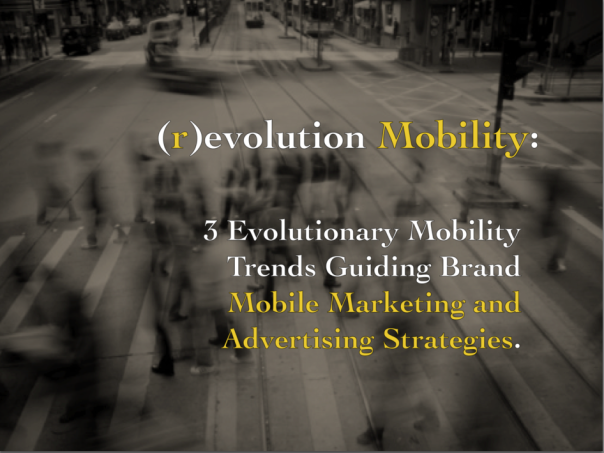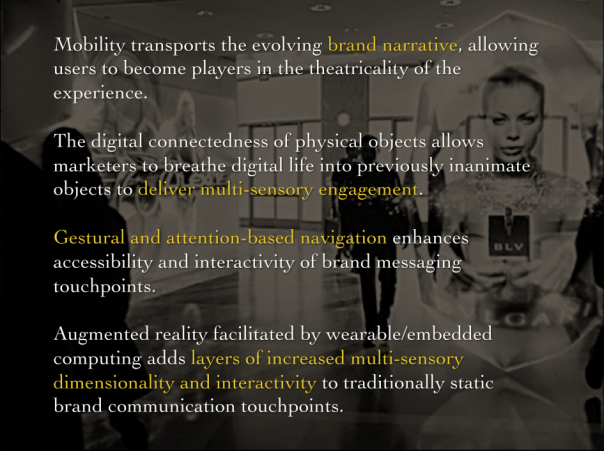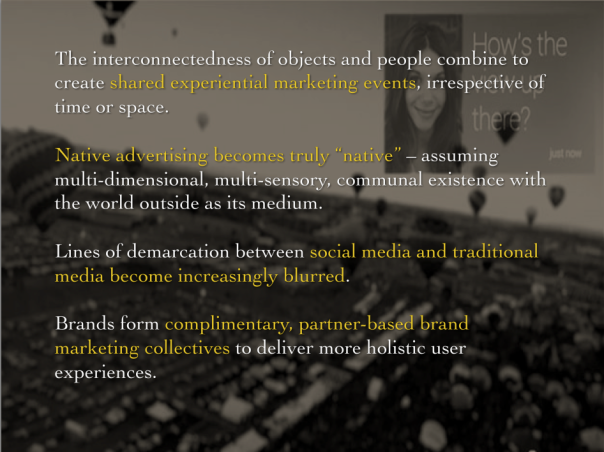
(This article was originally published by MarketingProfs)
As mobile has become the primary interface via which human beings experience an increasingly digitally optimized world, brands are being forced to adapt at an accelerated rate of change to create and maintain competitive advantage.
Increasing pressures from the executive suite force tactical decisions. Siloed efforts in mobile across rogue business units create unmanageable assets and unnecessary support issues. User demands accelerate by the day, forcing organizations to adopt reactionary tactics counter to corporate directives.
All of this mobility disruption to pre-existing models has created significant digital friction. Existing models for defining strategy are highly complex, time consuming, and based on methodologies designed for addressing an audience of stationary targets. The mobile experience is often initiated by moving targets and is defined not only by the message and the medium but also by the context of the user experience.
As a result, the complexity and associated analysis paralysis involved with developing strategies lead to organizational confusion and indecision. In this age of mobility, brands are faced with the dilemma of how best to manage ever-increasing complexities and prioritize efforts that add measurable value to the user and provide immediate impact for the business. The question is, more often than not, a fundamental one: Where do we start?
Lean Strategy: An Alternative to Existing Strategic Thinking
Successful strategies for mobility require a significant overhaul in approach. Success relies on quickly identifying and prioritizing mobility investments to create alignment and foster continuous innovation.
Brands need to gain clarity for mobile efforts. They need to stop thinking about large projects or big releases and embrace a decision-making framework executed in a series of short, informed, prioritized, and iterative cycles. A focus on deconstructing complexities is required to improve manageability, increase flexibility, and accelerate informed decisions measured by value to the user, value to the business, and ability to execute.
Systematically and intelligently prioritizing all of the initiatives proposed within and across lines of business poses considerable challenges. To simplify the prioritization process, focus needs to be on the identification and rapid formulation of informed project activation plans designed to quickly address mobility efforts.
When evaluated through the lenses of value to the user audience, value in alignment with business objectives, and organizational ability to execute, ideas transform into opportunities that take shape as highly valuable, immediately executable initiatives prioritized and poised for activation.
Agile Strategy Drives Actionable Insights and Informed Planning
When executed effectively, this lean framework approach to strategy should focus on three distinct yet interrelated steps designed to provide an informed road map to achieve more immediate success: investigation, formulation, and activation.
- Investigation begins with an understanding of current trends in the marketplace as well as the competitive landscape facing the organization. This analysis should be evaluated against an audit of the brand’s existing in-market mobile experiences. An understanding of user personas and their engagement journey, coupled with key stakeholders interviews within the organization, begins to form the key prioritization criteria of the value of a prospective effort to the user as well as its alignment with the objectives of the business.
- Formulation involves exploration into existing current and future mobility efforts and harnessing market trends, mobile experiences audit, and competitive analysis to identify unconsidered opportunities. In addition, a high-level assessment of the organization’s level of mobile maturity from the perspectives of people, process, and technology forms the basis for an understanding of the organization’s ability to execute.
- Activation combines all initiatives that have passed the litmus test of alignment with business strategy to be defined as opportunities. These opportunities should then be evaluated through the lenses of value to the user audience, value to the business, and organizational ability to execute to be assigned a prioritized ranking.
The prioritized opportunities deemed highest value form the basis for the lean activation plan, with the business case developed for the top initiatives, including cost and required resource models, technological dependencies, prospective ROI, and multi-phase road map for ongoing solution innovation.
Addressing the Need for Revised Strategic Models
Strategy is too often focused on technology, where the fascination with shiny objects often undermines the objectives of the organization. With mobility, simplicity is the ultimate sophistication, and the brand requires an understanding of the delicate balance between the art of possible and the art of pragmatism.
Adopting lean principles for strategy ensures that complexity, rigidity, and friction are replaced with simplicity, adaptability, and speed. Accelerating market demands can only be combated through accelerated road-mapping developed through actionable insights and informed planning.
Assuming the lead in driving innovation is the challenge ahead. Is your organization prepared for leadership?
Key Takeaways
- Success relies on iteratively identifying and prioritizing mobility investments to create alignment and foster continuous innovation.
- Embrace a lean strategy framework executed in a series of short, informed, prioritized and iterative cycles.
- Adopting lean principles for strategy ensures that complexity, rigidity, and friction are replaced with simplicity, adaptability, and speed.








 2012 was a year of tremendous evolutionary shift in consumer behavior and brand engagement. This shift was enabled primarily by the mobile device, offering unparalleled instantaneous consumer access to brands and fueling a (r)evolution that has toppled traditional B2C marketing and ushered in a new world order C2B model of consumer brand engagement.
2012 was a year of tremendous evolutionary shift in consumer behavior and brand engagement. This shift was enabled primarily by the mobile device, offering unparalleled instantaneous consumer access to brands and fueling a (r)evolution that has toppled traditional B2C marketing and ushered in a new world order C2B model of consumer brand engagement.







